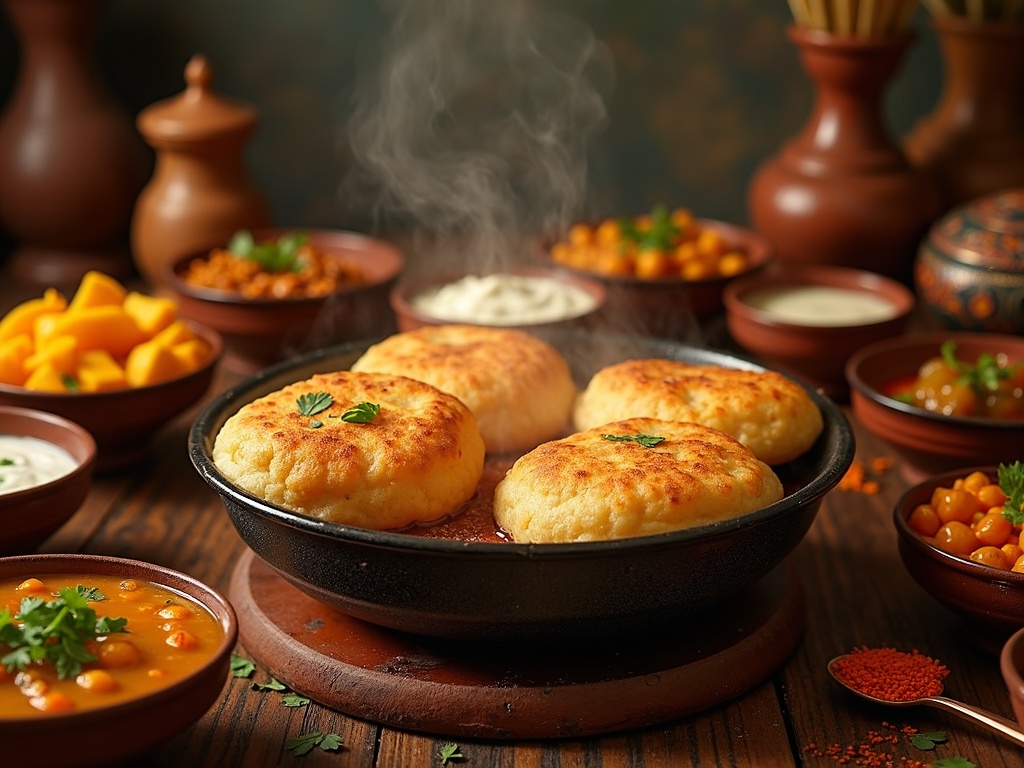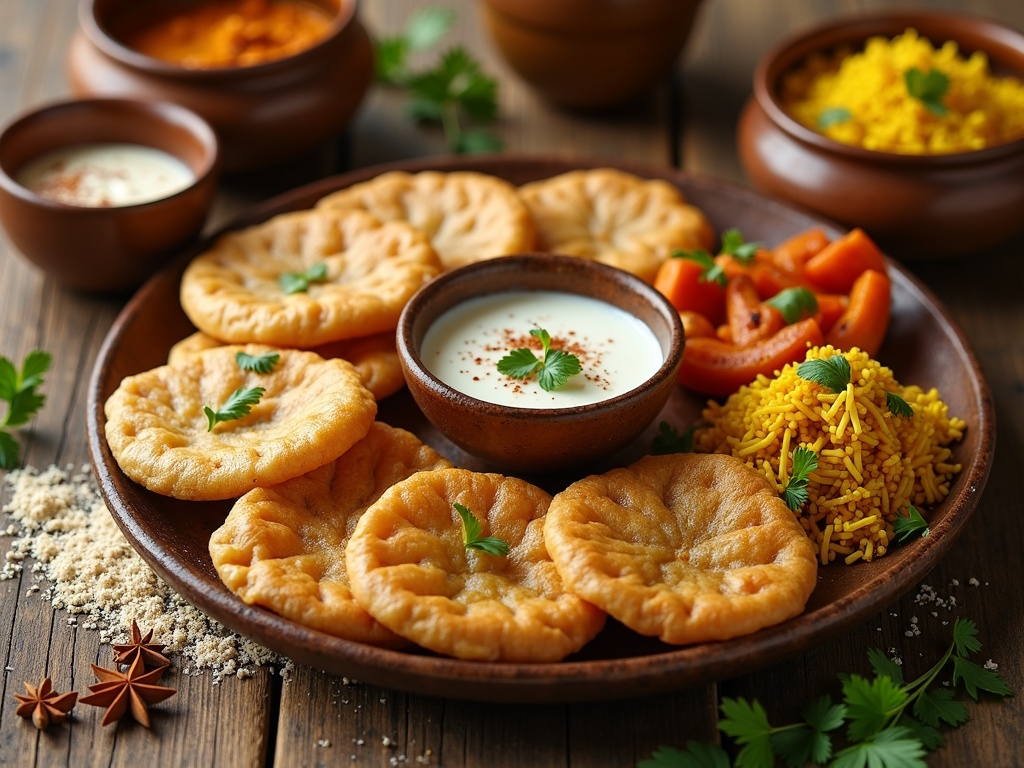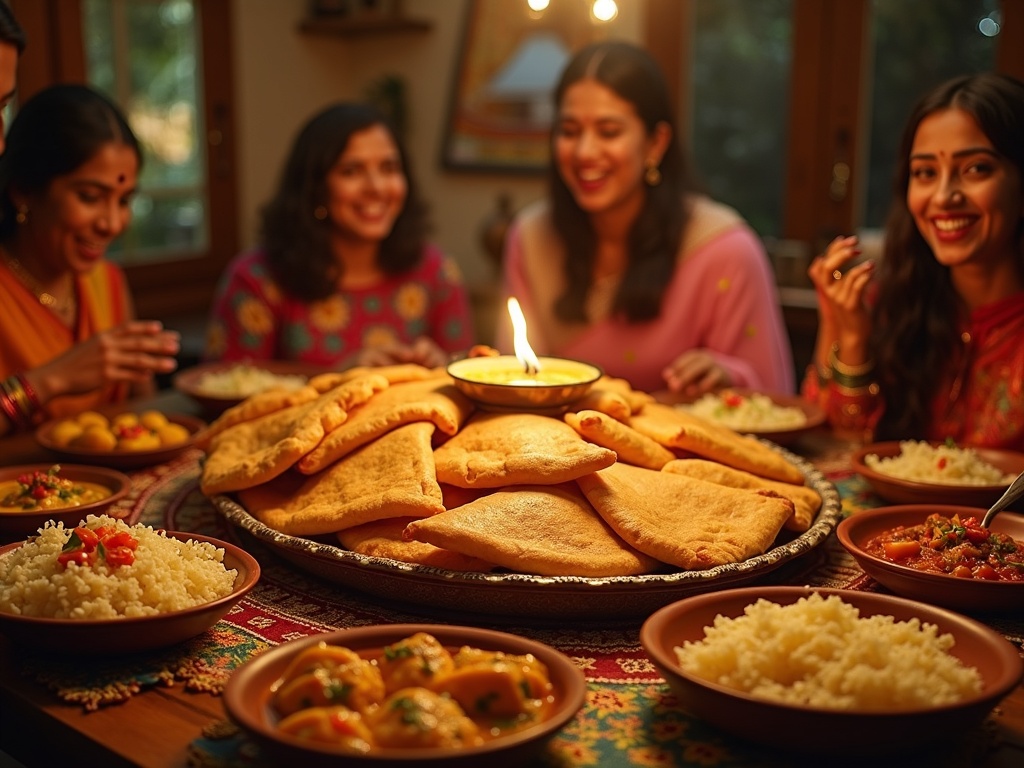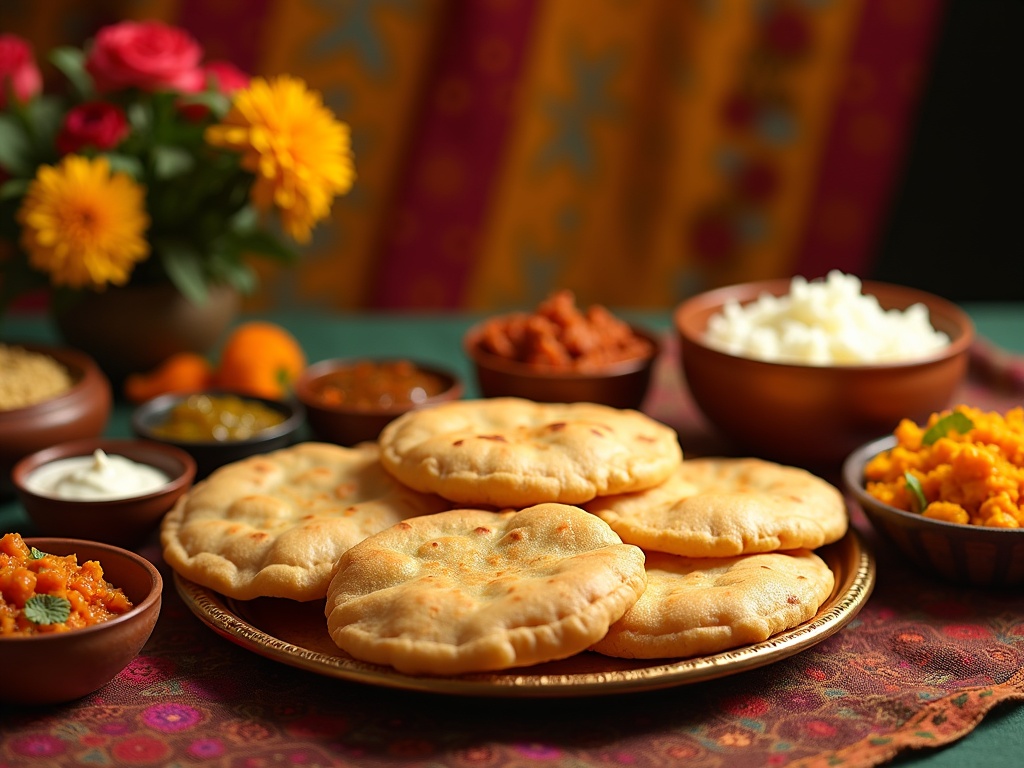Poori, a deep-fried unleavened bread made from whole wheat flour, ranks as one of the most beloved staples in Indian cuisine with its distinctive puffed texture and golden hue. This versatile bread holds cultural significance across the Indian subcontinent, appearing in everything from everyday meals to religious ceremonies and festivals, where it’s paired with various curries, vegetables, and even sweet dishes.
Find In This Article
Key Takeaways
- Traditional pooris are made from whole wheat flour, salt, and water, with the dough rested before being rolled into small circles and deep-fried until they puff up.
- When made with whole wheat flour, pooris provide essential nutrients including B vitamins, iron, magnesium, and zinc, along with dietary fiber that supports digestive health.
- Pooris hold cultural significance in Indian celebrations, symbolizing prosperity and hospitality at weddings, religious ceremonies, and family gatherings.
- Regional variations include Suji Poori (made with semolina), Aloo Poori (stuffed with potato), Bhatura (larger and softer), and Luchi (made with refined flour).
- Classic accompaniments vary by region, from spicy chole (chickpea curry) in North India to coconut-based curries in South India, creating distinctive flavor combinations.
What Makes Poori Special in Indian Cuisine
Poori stands out as one of the most beloved bread varieties in Indian cuisine. This deep-fried unleavened bread made from whole wheat flour (atta) has captured hearts across the Indian subcontinent with its distinctive characteristics and versatility.
A Culinary Treasure with Rich Heritage
The magic of poori lies in its signature puffed texture and golden color, achieved through a specific cooking technique. When the flattened dough circles hit the hot oil, they instantly puff up into beautiful golden balloons – a sight that brings joy to any dining table. This transformation isn’t just visually appealing but creates a unique texture that’s crispy on the outside while remaining soft and layered within.
Poori has deep roots in the Indian subcontinent, with variations found across different regions. Its popularity extends beyond India to neighboring countries like Pakistan and Nepal, where families prepare it for special occasions and everyday meals alike.
What makes poori truly special is its incredible versatility. I’ve found it pairs perfectly with:
- Savory potato curry (aloo sabzi) for a classic breakfast combination
- Chickpea curry (chole) for a protein-rich meal
- Sweet halwa for a delightful contrast of flavors
- Simple yogurt and pickle for a quick, satisfying snack
The preparation process contributes to poori’s distinctive character. The dough combines whole wheat flour with water and salt, then gets a rest period before being rolled into small circles. This resting stage is crucial for developing the right texture. Unlike its cousin roti which is cooked dry, poori’s deep-frying method creates that characteristic puff and golden hue.
I’ve noticed poori holds a special place at celebrations and religious ceremonies across India. Its presence at festival tables makes it more than just food – it’s part of cultural identity and tradition. During special occasions, many families serve various bread types including poori as the centerpiece of elaborate meals.
The joy of watching a perfectly made poori puff up in hot oil is matched only by the satisfaction of tearing into its crispy exterior. This humble bread showcases how simple ingredients transform into something extraordinary through traditional cooking techniques passed down through generations.

Traditional Recipe and Cooking Method
The art of making the perfect poori lies in getting the dough consistency and oil temperature just right. I’ve found that a well-balanced dough creates that magical puff when it hits the hot oil. To create authentic pooris, I start with a simple mix of whole wheat flour (atta), salt, and a touch of oil to make the dough pliable.
Step-by-Step Preparation Process
For the dough, I combine 2 cups of whole wheat flour with ½ teaspoon of salt and 1 tablespoon of oil. I gradually add water, about ¾ cup, kneading until I get a smooth, firm dough that’s slightly stiffer than regular roti dough. The dough needs to rest for at least 20-30 minutes, covered with a damp cloth to prevent drying.
After resting, I divide the dough into small lemon-sized balls and roll each into a small circle about 4-5 inches in diameter. The thickness is crucial – not too thin or they won’t puff, not too thick or they’ll remain raw inside. A rolling thickness of about 1/8 inch works perfectly.
The oil temperature is absolutely critical for that perfect puff. I heat oil in a deep pan to 350-375°F (175-190°C). A simple test I use is dropping a small piece of dough in the oil – it should rise to the surface immediately without browning too quickly.
When frying pooris, I gently slide them into the hot oil and press lightly with a slotted spoon to encourage puffing. Each poori takes about 15-20 seconds per side, turning once, until it’s golden brown. I drain them on paper towels to remove excess oil before serving.
For those looking to reduce oil consumption, these alternative cooking methods can work well:
- Shallow frying with just 2-3 tablespoons of oil in a pan
- Baking in a preheated oven at 400°F (200°C) for about 7-8 minutes, brushed lightly with oil
- Air frying at 375°F (190°C) for 4-5 minutes after a light oil spray
While these methods don’t create the exact same texture as traditional deep-fried pooris, they’re healthier options that still taste delicious.
Pooris are traditionally paired with flavorful dishes that complement their crisp texture. Some classic combinations include:
- Aloo bhaji (spiced potato curry)
- Chole (chickpea curry)
- Saag (spinach curry)
- Halwa (sweet semolina pudding)
- Simple yogurt and pickle
For breakfast, I love serving pooris with a side of savory upma for a balanced meal. The combination of crispy pooris with fluffy upma creates a delightful contrast of textures.
To achieve that perfect golden color and ideal texture, I’ve learned these crucial tips over years of poori-making:
- Never use all-purpose flour alone – the best pooris come from whole wheat flour or a mix with a higher proportion of whole wheat
- Adding a spoonful of hot oil to the dough helps create a crispier texture
- Roll the pooris evenly to ensure uniform cooking
- Maintain constant oil temperature throughout the frying process
- Fry one poori at a time for beginners, or a maximum of two for experienced cooks
If you’re looking to expand your Indian bread repertoire, consider trying your hand at butter naan or tandoori roti for variety in your meals.
With practice, making pooris becomes second nature. The joy of watching them puff up in hot oil never gets old, and the satisfaction of serving these golden discs alongside a flavorful pulao makes the effort worthwhile.
Health Benefits and Nutrition Facts
I’ve found that poori, the delicious deep-fried Indian bread, offers more nutritional value than many people realize. A standard poori (approximately 30 grams) contains 90-100 calories, making it a relatively moderate calorie choice when enjoyed as part of a balanced meal. Each poori typically provides 15-20 grams of carbohydrates, which serve as an excellent energy source for daily activities.
While poori isn’t necessarily protein-rich, it does contain 2-3 grams of protein per piece, contributing modestly to your daily protein requirements. The cooking method naturally results in 4-5 grams of fat per poori, which helps create that satisfying texture and flavor we all love. You’ll also get about 1 gram of fiber per piece, which supports digestive health.
Nutritional Advantages of Whole Wheat Poori
When made with whole wheat flour rather than refined flour, poori delivers significantly more benefits. The whole wheat version contains essential dietary fiber that promotes gut health and can help you feel fuller longer. I’ve noticed that eating whole wheat poori as part of a meal can help regulate blood sugar levels due to its complex carbohydrate content, preventing the rapid spikes often associated with refined grains.
Whole wheat poori also offers vital vitamins and minerals that support overall health:
- B vitamins for energy metabolism and nervous system function
- Iron for healthy blood cell production
- Magnesium for muscle and nerve function
- Zinc for immune support and cell growth
I recommend pairing poori with protein-rich sides like flavorful pulao or vegetable curries to create a more complete meal. This combination helps balance the carbohydrate content while adding additional nutrients. For a lighter option, try serving poori with yogurt and a simple vegetable upma on the side.
When made at home, you can control the oil quality and quantity, making poori a more wholesome choice compared to many store-bought versions. Using heart-healthy oils like olive or avocado oil can further enhance the nutritional profile of this beloved bread.

Cultural Importance and Celebrations
Poori holds a special place in the cultural fabric of India, extending far beyond just being a delicious bread. I’ve noticed how this deep-fried delight appears at virtually all significant life events and religious ceremonies across the country. During Hindu festivals like Navratri, Diwali, and Janmashtami, poori is often the centerpiece of ritual meals, symbolizing prosperity and celebration.
In Indian weddings, serving poori to guests is considered auspicious and a sign of hospitality. The golden, puffy bread represents abundance and is typically paired with special curries reserved for these momentous occasions. Family gatherings, whether for birthdays, anniversaries, or simply Sunday brunches, often feature this beloved bread as a way to elevate the meal from ordinary to special.
Regional Variations and Serving Traditions
Different regions across India have created their own unique poori varieties that reflect local tastes and ingredients:
- Suji Poori: Made with semolina instead of wheat flour, offering a distinctive texture that’s particularly popular in North Indian celebrations.
- Aloo Poori: Stuffed with spiced potato filling, commonly served for breakfast in Punjab and parts of North India.
- Bhatura: A close cousin to poori but larger and softer, traditionally paired with chole (chickpea curry) in Delhi and surrounding regions.
- Luchi: The Bengali variation made with maida (refined flour) rather than whole wheat, served during special occasions.
The communal experience of eating poori connects to ancient Indian traditions of shared meals. I’ve observed how in traditional settings, pooris are often served fresh off the stove, creating an interactive dining experience where family members gather around to enjoy them while still hot and at their puffiest state. This bread pairs beautifully with both vegetable dishes and aromatic rice preparations like pulao.
The serving customs vary by region but typically involve presenting pooris in a thali (platter) alongside complementary dishes. In some homes, pooris are stacked in covered baskets lined with cloth to keep them warm. This presentation style enhances the ceremonial feeling of the meal and maintains the bread’s texture until serving time.
For everyday meals, many families serve poori with simple side dishes, but for festivals, it’s paired with elaborate preparations, showing how this bread can transition seamlessly between casual and formal dining contexts. When served with potato-based dishes, the combination creates a satisfying meal that has sustained generations.

Regional Variations and Accompaniments
Poori, the beloved deep-fried bread, takes on fascinating regional characteristics across India. In Punjab, I’ve noticed they make their pooris slightly thicker and often include ajwain (carom seeds) in the dough for digestive benefits. Meanwhile, South Indian variations might incorporate a hint of rice flour for extra crispness, creating a lighter texture that pairs wonderfully with their coconut-based curries.
Popular Poori Pairings
The accompaniments served with pooris vary dramatically by region, reflecting local ingredients and traditions:
- Chole (spiced chickpeas): In North India, particularly Delhi and Punjab, this rich, tangy chickpea curry is the classic poori partner. The combination of fluffy pooris with spicy chole creates a perfect breakfast or celebratory meal.
- Saag (cooked greens): In states like Uttar Pradesh and Bihar, pooris often accompany seasonal greens cooked with minimal spices. This healthier pairing balances the indulgence of fried bread with nutritious vegetables.
- Bhaji (fried vegetables): Western states like Gujarat and Maharashtra prefer serving pooris with potato-based bhaji. The contrast between the crisp pooris and soft, spiced vegetables makes for a satisfying meal.
- Halwa: In many homes, especially during festivals, pooris are paired with sweet semolina or carrot halwa, creating a delightful sweet and savory combination.
Regional spice preferences add another dimension to poori variations. Northern regions might include cumin in the dough, while eastern regions sometimes add a pinch of sugar for a subtle sweetness. Some coastal areas even incorporate coconut into the dough, creating a distinctive flavor profile that complements their seafood-based side dishes.
Serving customs vary too – in some households, pooris are stacked high on festive occasions as a symbol of abundance, while others serve them piping hot, one at a time. In Bengal, pooris accompany savory potato dishes during Durga Puja celebrations, while in Gujarat, they’re often served with sweet semolina dishes during religious ceremonies.
For an authentic experience, try making regional variations at home. You might discover that Southern-style pooris paired with aromatic rice dishes become your new favorite combination, or perhaps the robust flavors of Rajasthani pooris served with spicy dal will win your heart.
Sources:
Indian Bread Types: A Culinary Guide
Nutritional Values of Common Indian Foods
The Cultural Impact of Indian Food

